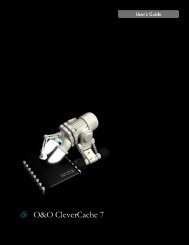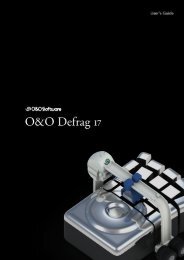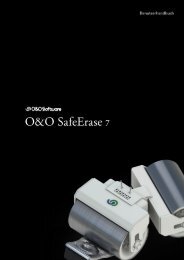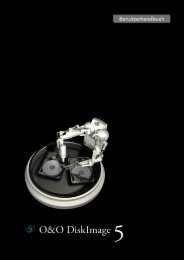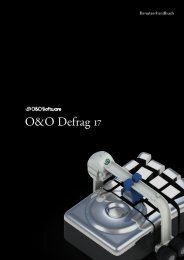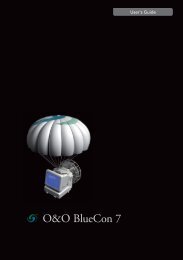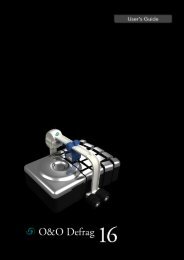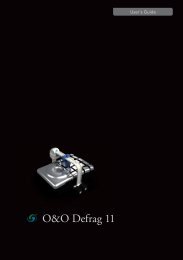O&O DiskImage 7 User's Guide - O&O Software
O&O DiskImage 7 User's Guide - O&O Software
O&O DiskImage 7 User's Guide - O&O Software
Create successful ePaper yourself
Turn your PDF publications into a flip-book with our unique Google optimized e-Paper software.
Frequently asked questions<br />
This can occur if you have, for example, defragmented your computer in the meantime. The newly structured file segments<br />
will then be recognized as “changes” and imaged as new files.<br />
What does "Drive cannot be locked" mean? Does this affect the data imaging?<br />
As a result of system processes having to be in constant operation, it's not normally possible for system partitions to<br />
be locked. You get this notification even when you want to image a data drive and this is directly integrated into the system<br />
processes. The notification doesn’t generally have an effect on the imaging process; it is still able to be run without<br />
a problem. To be totally sure, shut down all running system applications, e.g. defragmentation or cloning processes,<br />
before imaging.<br />
While imaging, O&O <strong>DiskImage</strong> reports that the target volume is too small although the source drive is smaller<br />
than the target disk. What is the reason for this?<br />
Make sure you haven’t selected the entire hard disk as your source. Example:<br />
You have a hard disk with 100GB that is divided into two partitions:<br />
• System partition (20GB)<br />
• Data partition (80GB)<br />
• While trying to save the system partitions on an external 40GB hard disk, O&O <strong>DiskImage</strong> reports that the target<br />
volume is too small.<br />
By just making a check, you can select the system partitions as your only source, and not the entire hard disk.<br />
What do I do if O&O <strong>DiskImage</strong> takes very long to start, or doesn't even start at all?<br />
Please read the note about System requirements and make sure you're using the latest versions of your drivers.<br />
During restoration, O&O <strong>DiskImage</strong> created a new temporary file on my hard disk. Where does this file come<br />
from?<br />
Before creating an image, O&O <strong>DiskImage</strong> normally deposits a number of metadata in a local file. This data is needed<br />
by O&O <strong>DiskImage</strong> in order to create the image. The file will be included in the imaging to assure consistency in the<br />
image. This file will normally be automatically removed during restoration.<br />
Under certain circumstances, it's possible that another action of the operating system or the user will prevent this temporary<br />
file from being deleted. This will then result in the file remaining undeleted in the system. You can, however,<br />
delete this temporary file without any risk.<br />
Why are partitions that weren't imaged displayed when mounting an image in Explorer?<br />
In addition to saving data from the partition being imaged, O&O <strong>DiskImage</strong> also needs to save information about the<br />
disk on which that partition was originally located. All of this is required for mounting an image, converting it into a virtual<br />
disk, or performing any future restoration. There will also be information included about partitions that were not<br />
imaged. When mounting an image, just as when using a virtual hard disk after conversion from an image, Microsoft<br />
Windows uses this information to recognize that there were originally multiple partitions on the disk, and attempts to<br />
integrate them into the system. Because information/data about these partitions is missing, it's not possible to assign<br />
them to any file system. As a result, partitions that weren't imaged will be displayed as RAW, i.e., non-formatted.<br />
Frequent questions on authentication<br />
Where do I find the domain and user name to use for authentication?<br />
If you are not sure, please proceed as follows:<br />
• Call the command line under Run... in the Start menu. Enter the command cmd in the dialogue.<br />
O&O <strong>DiskImage</strong>-88



